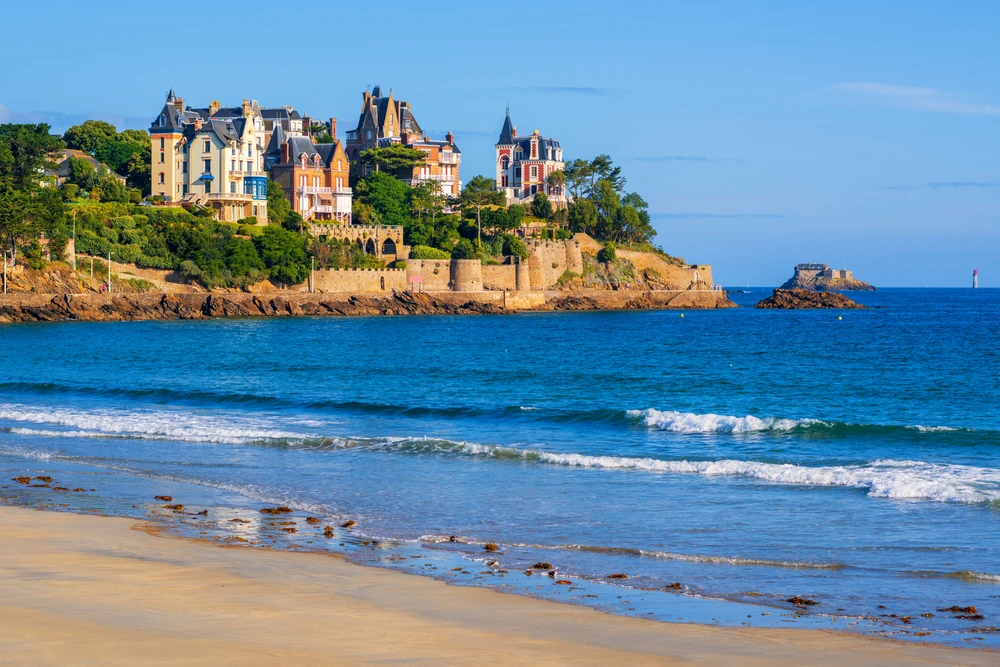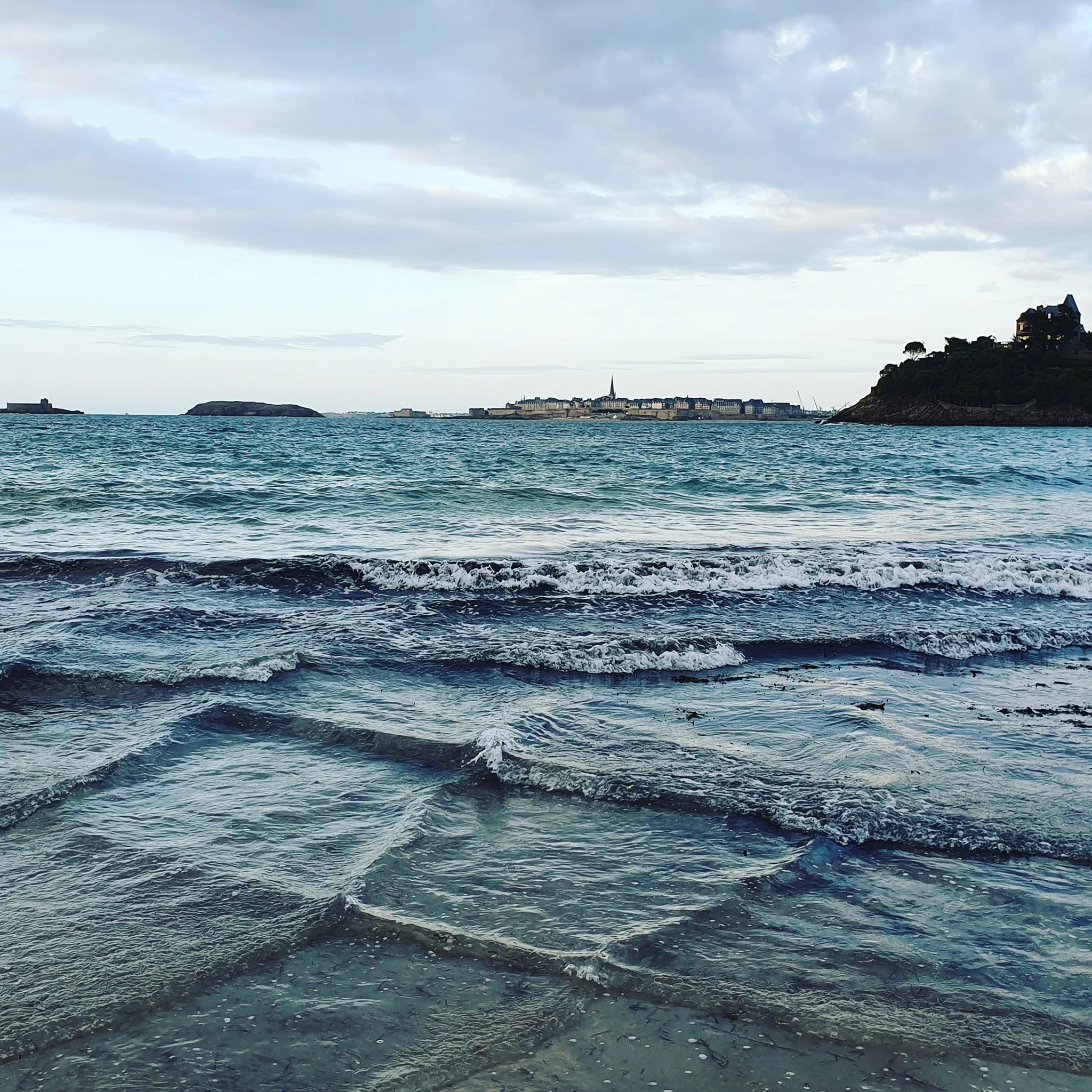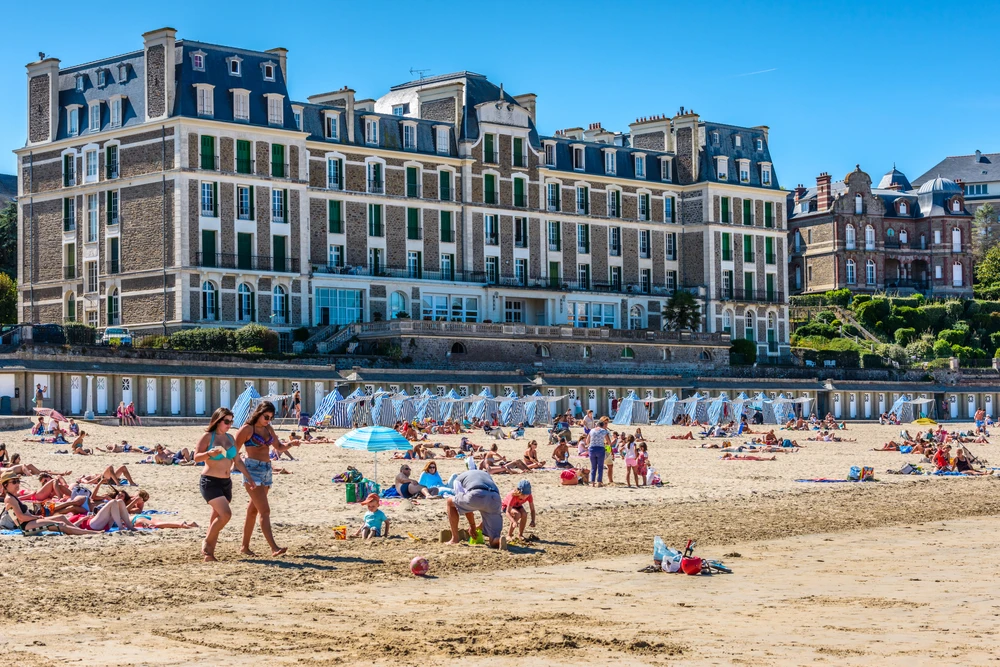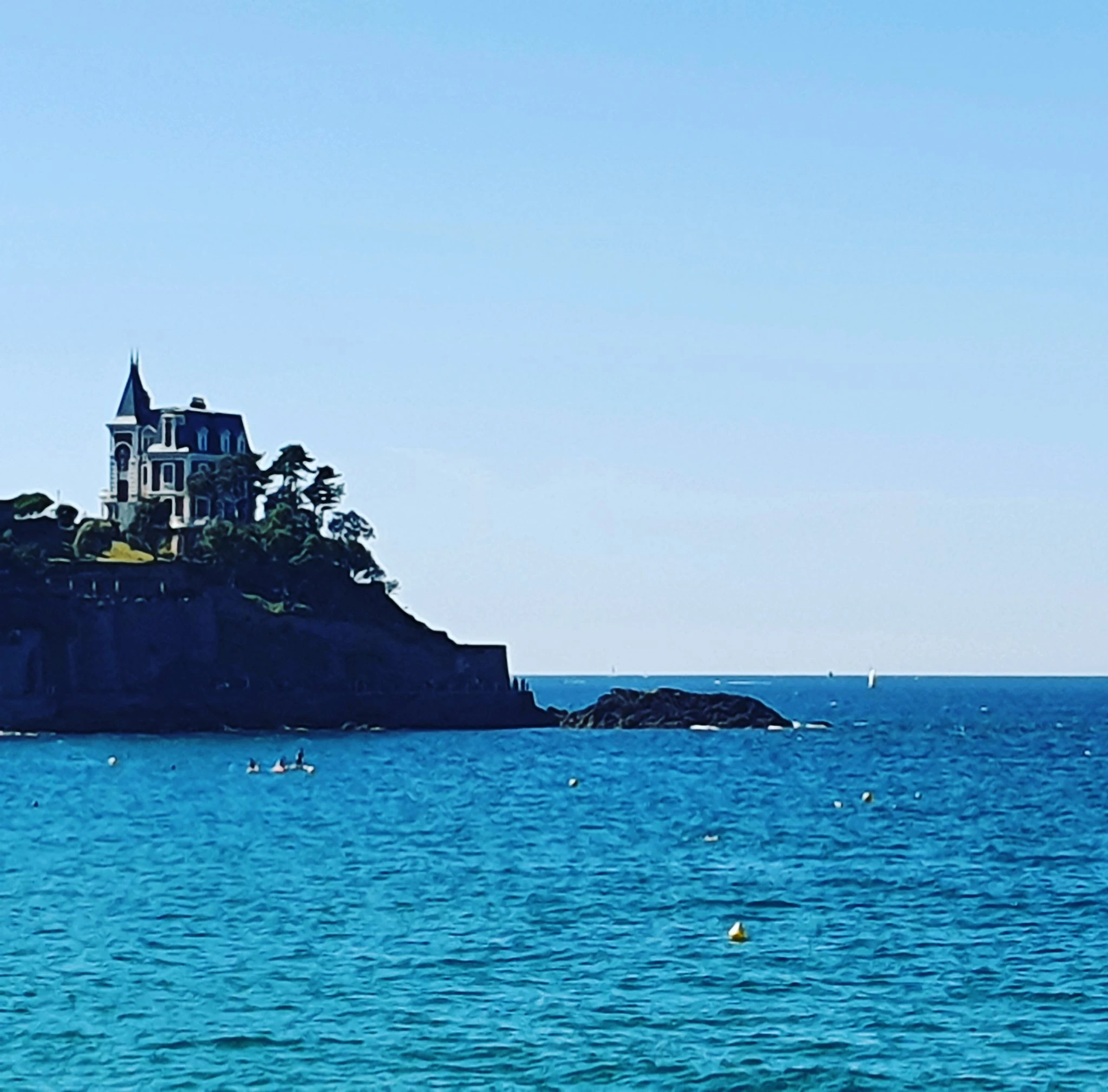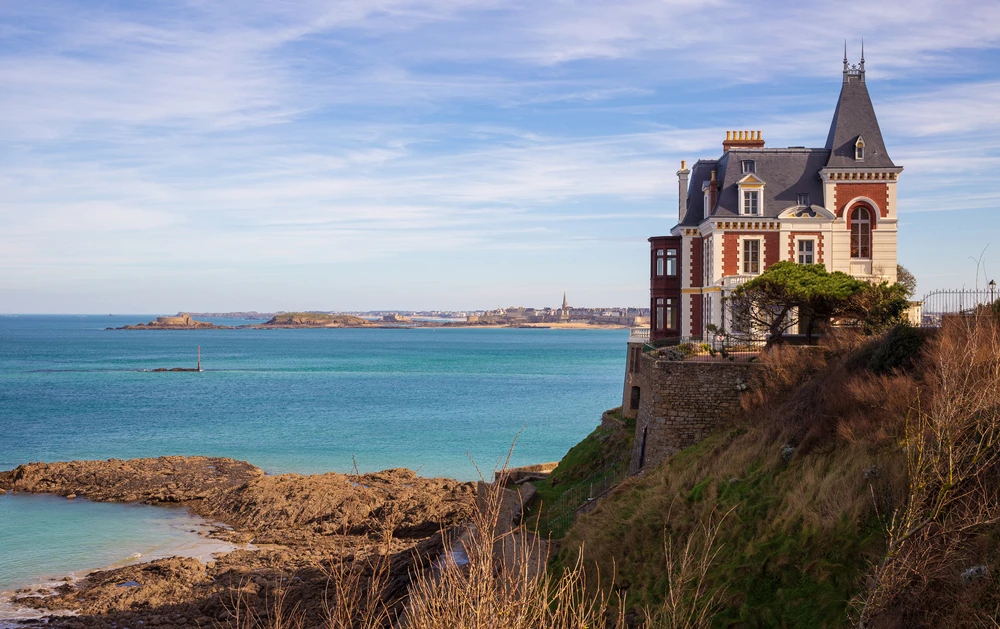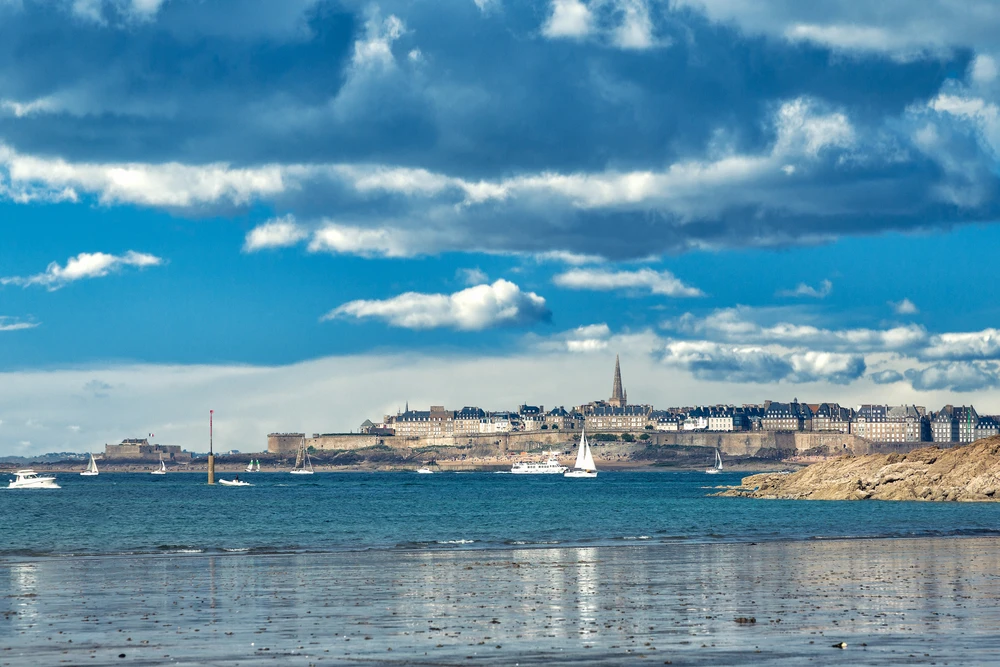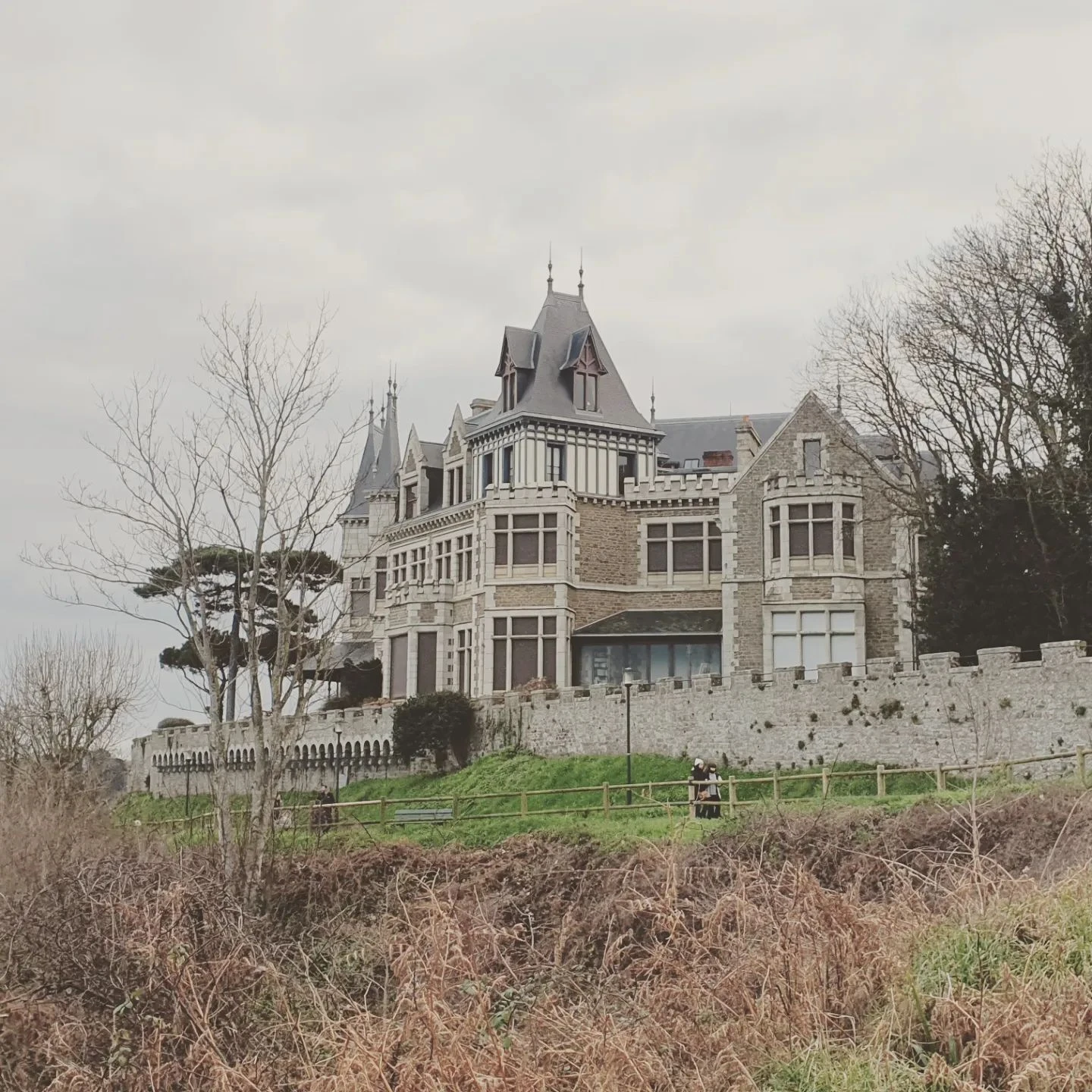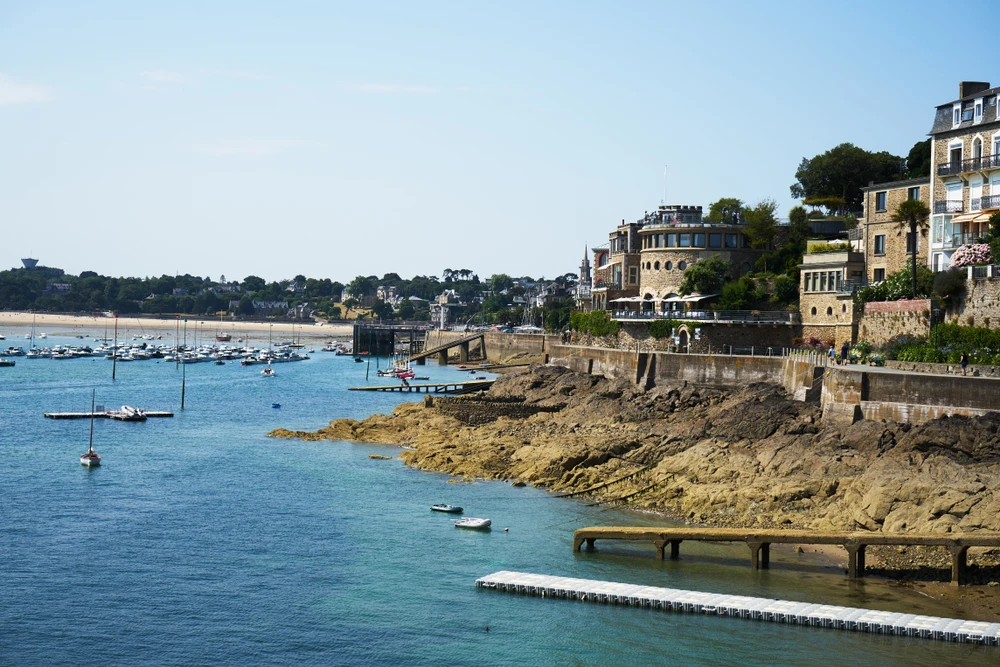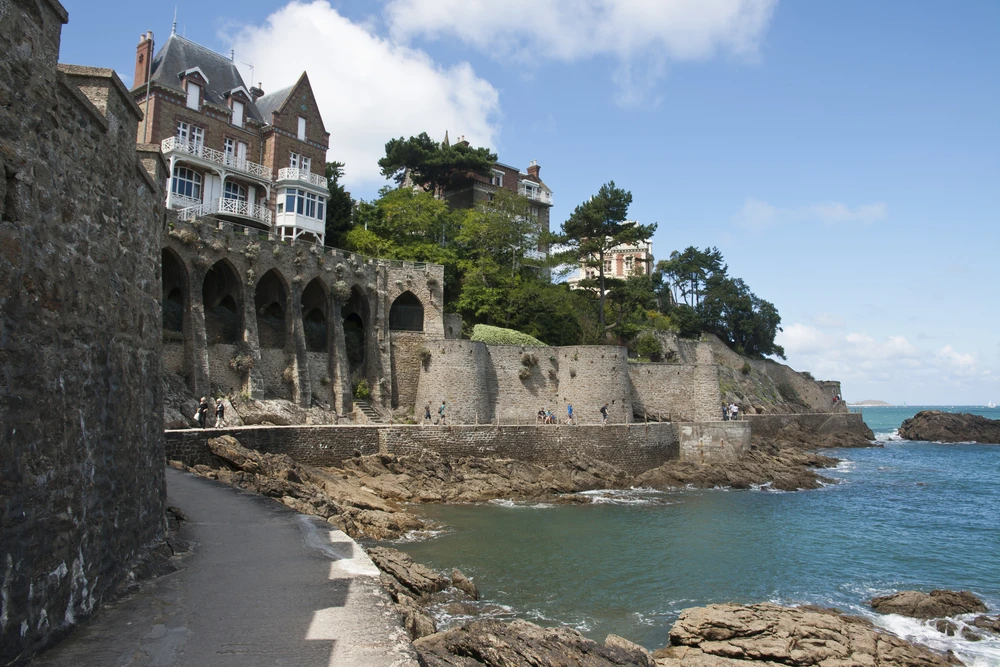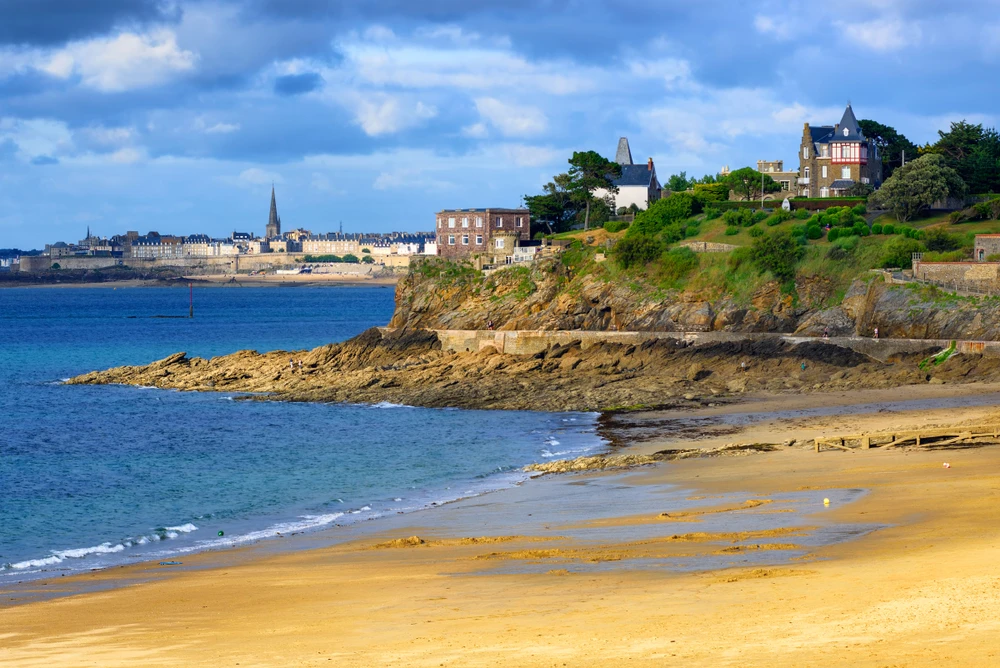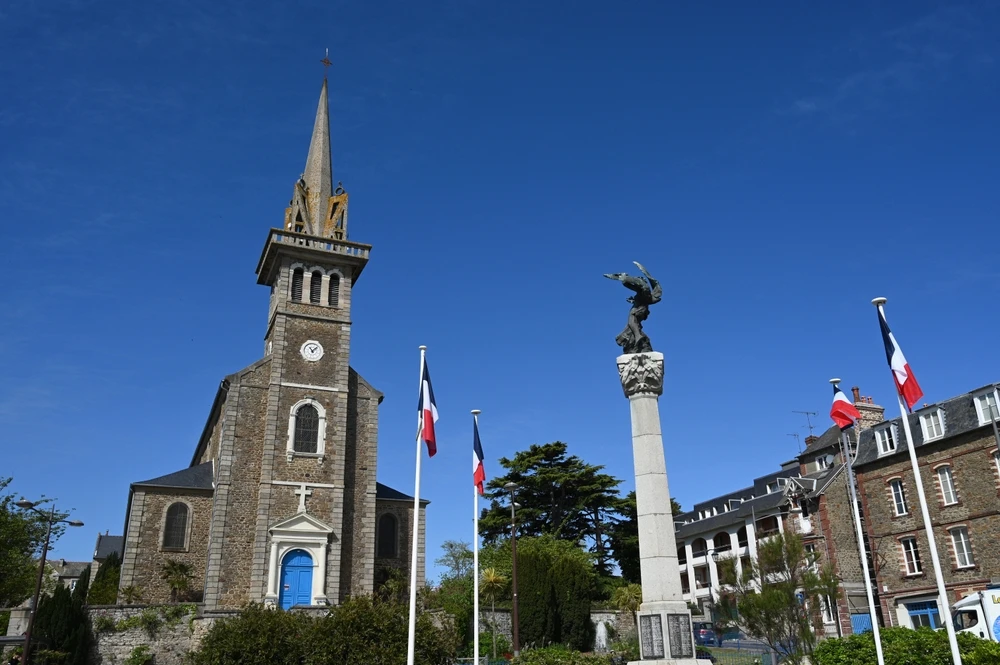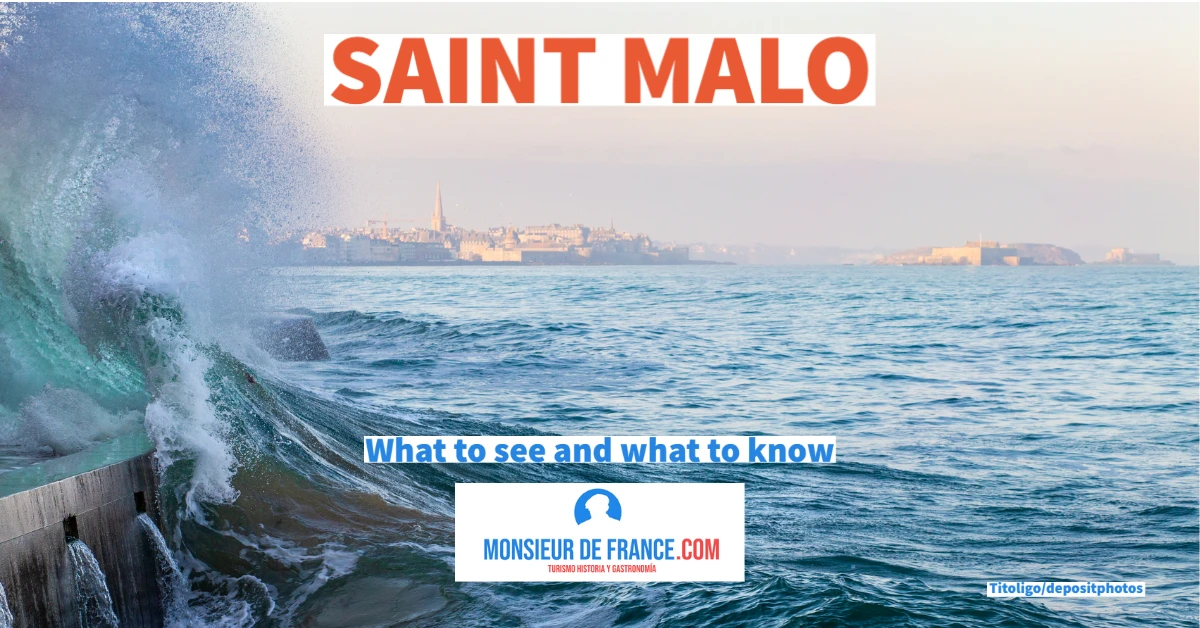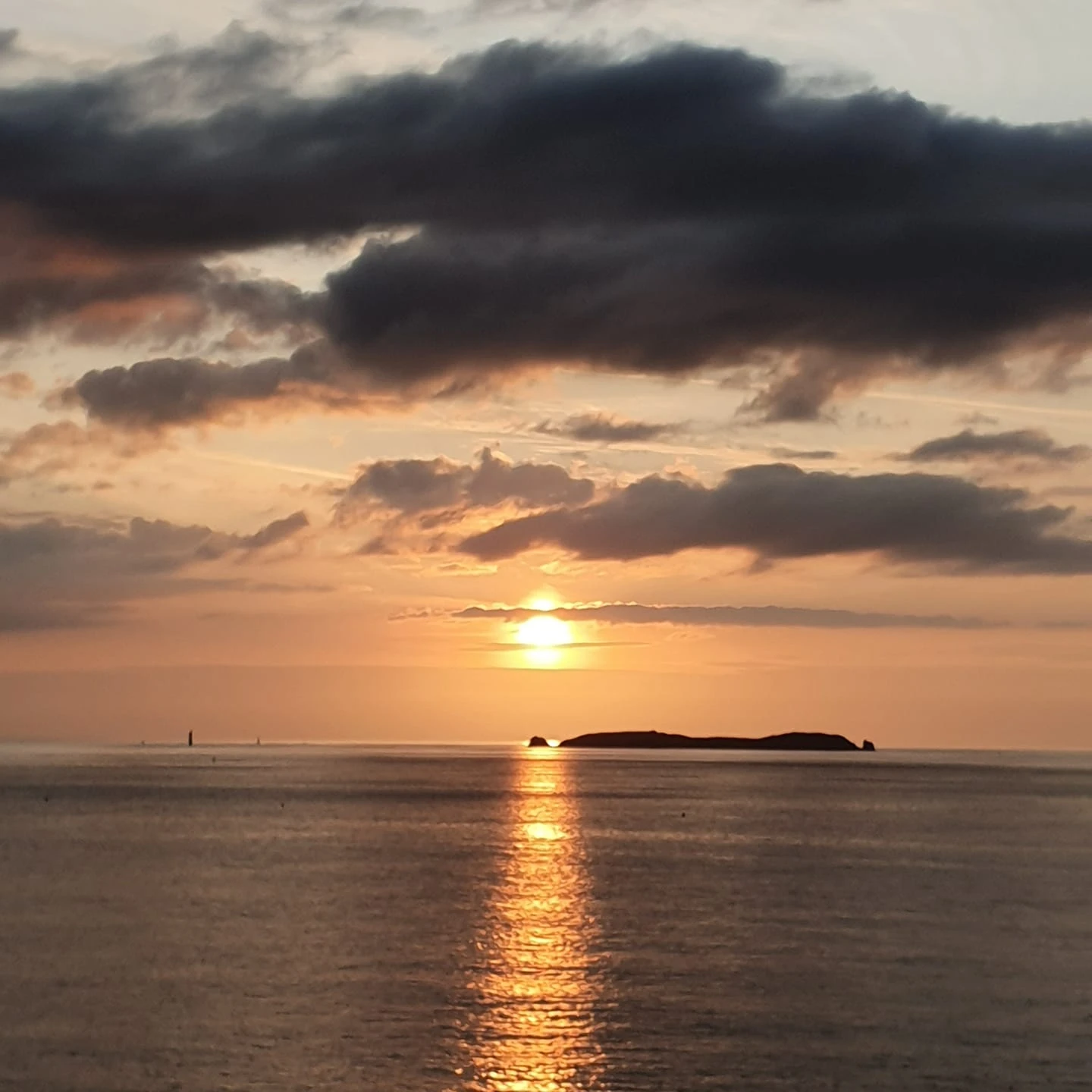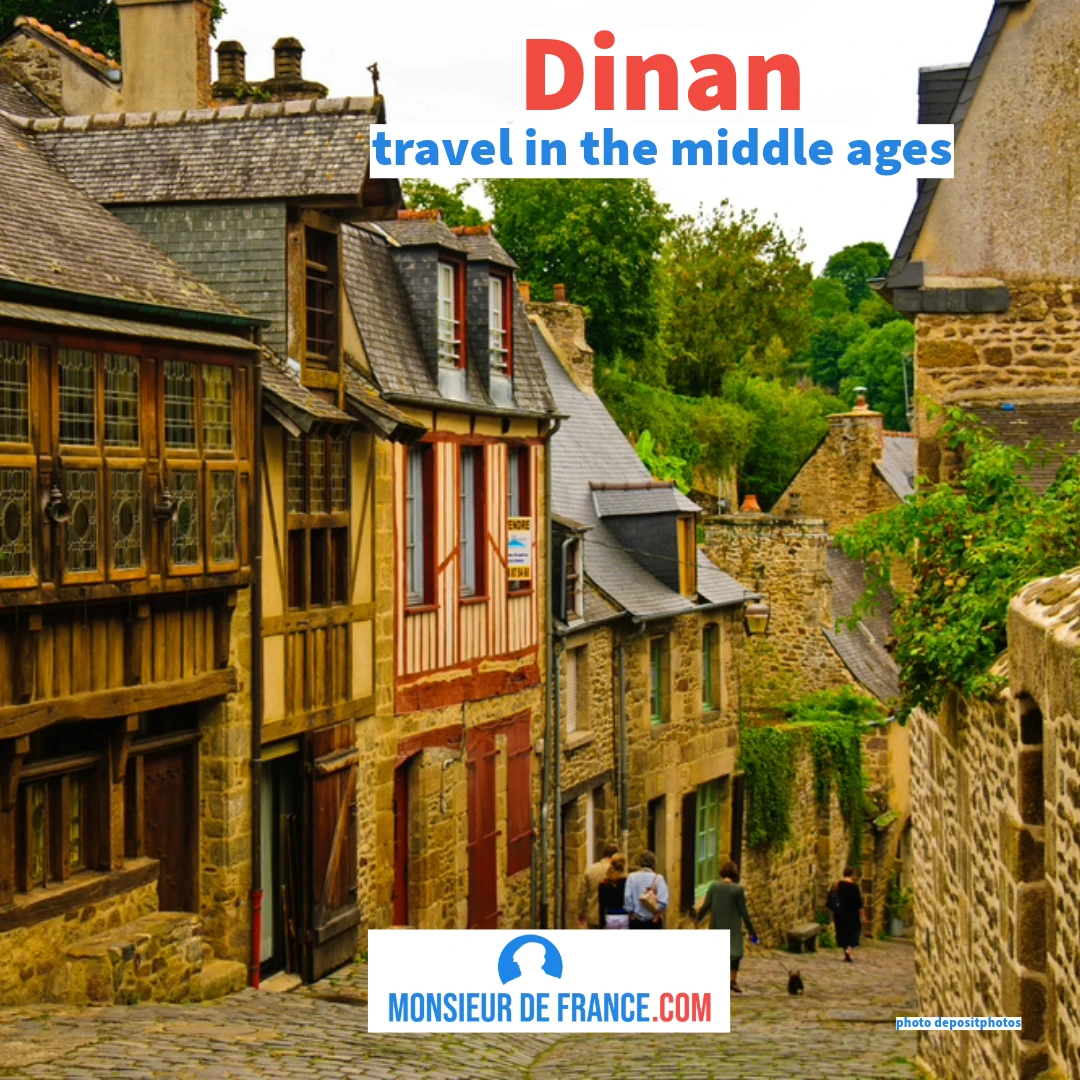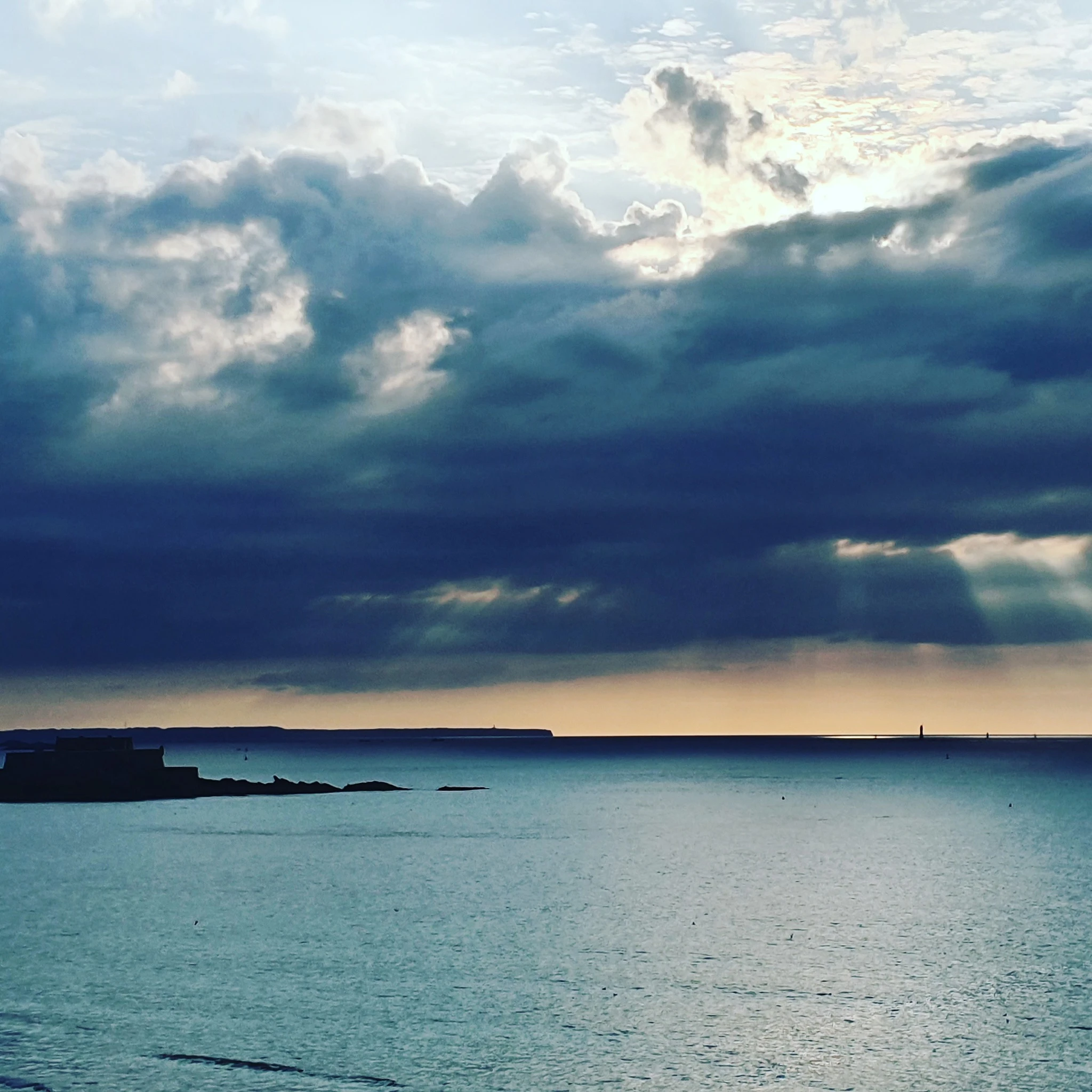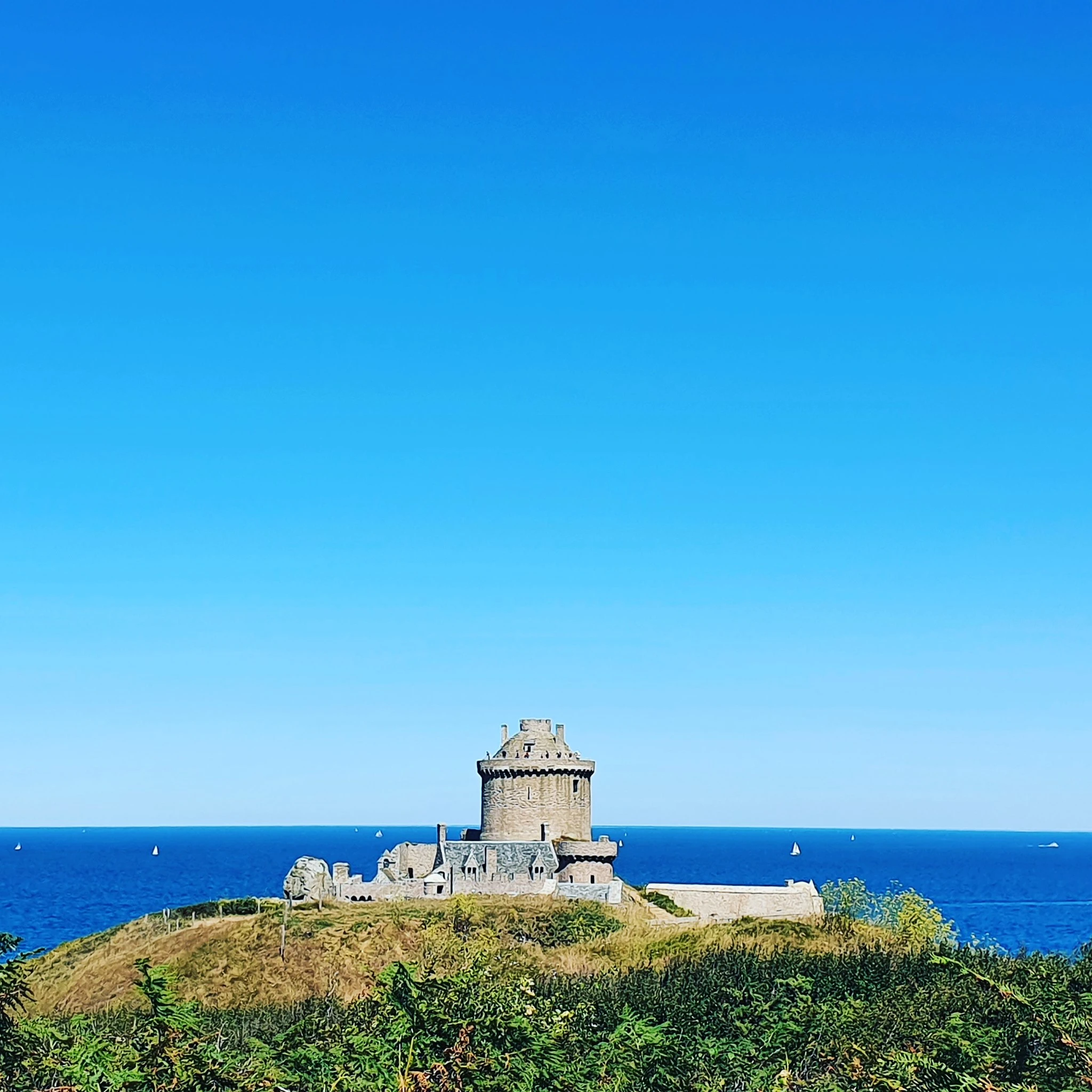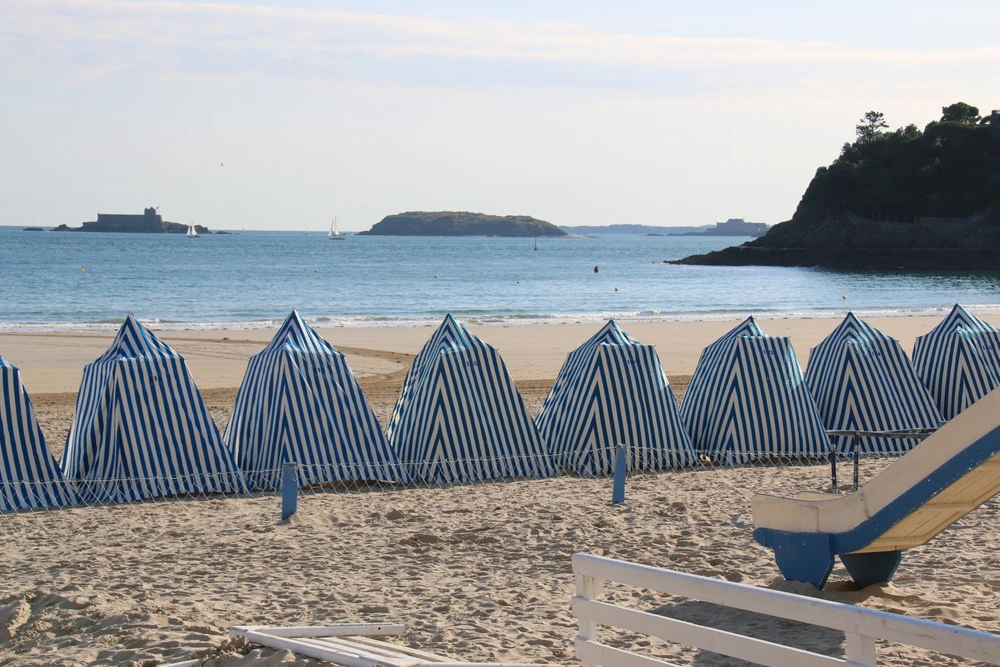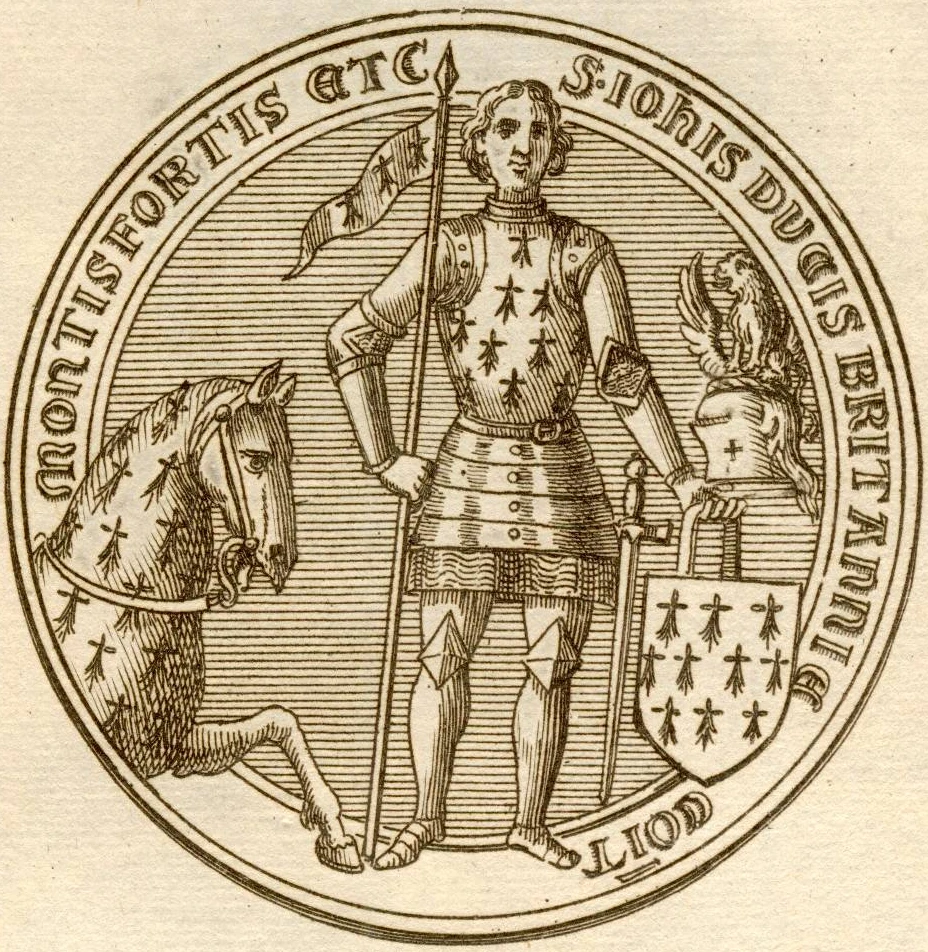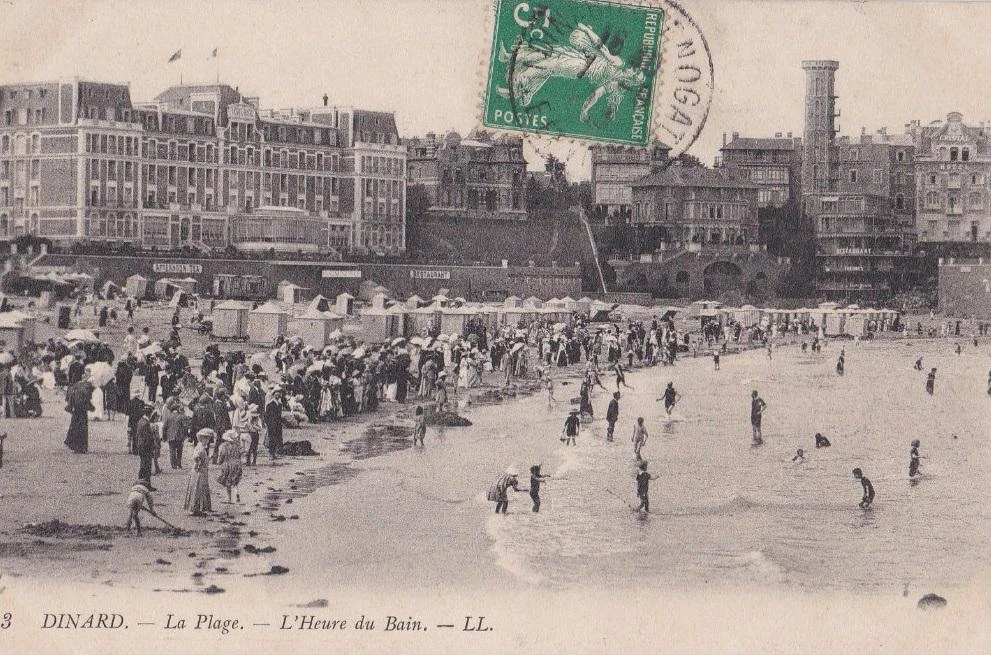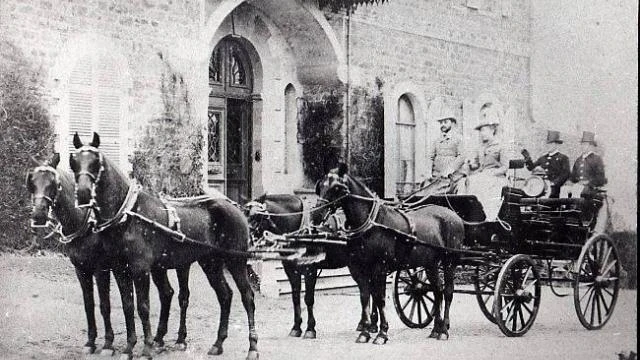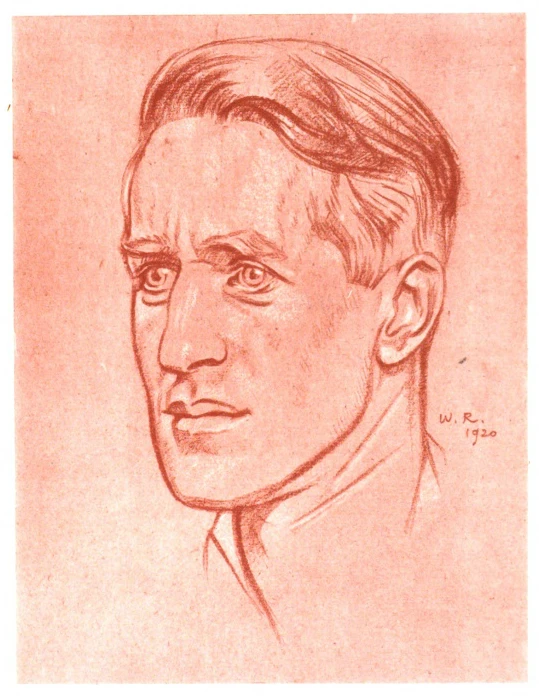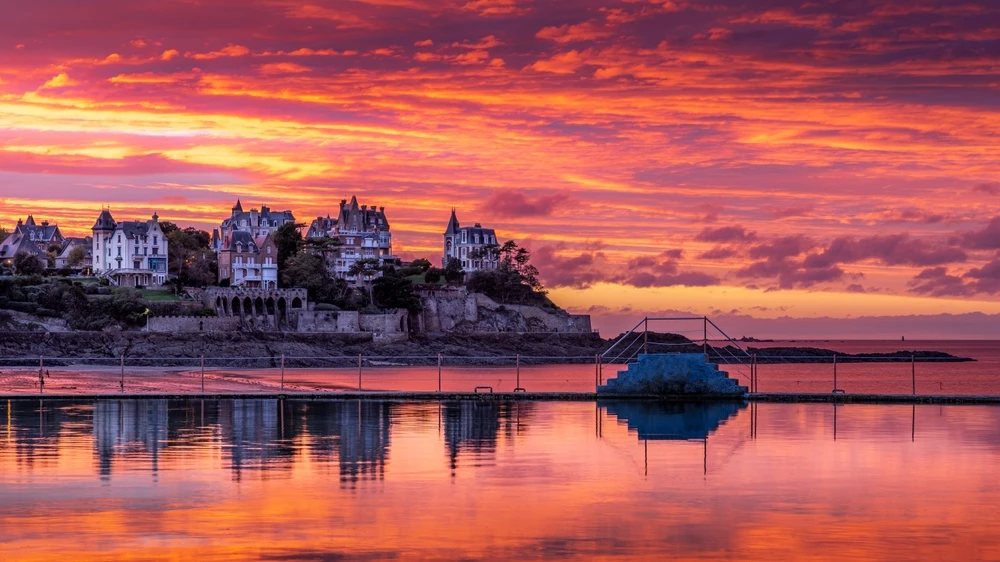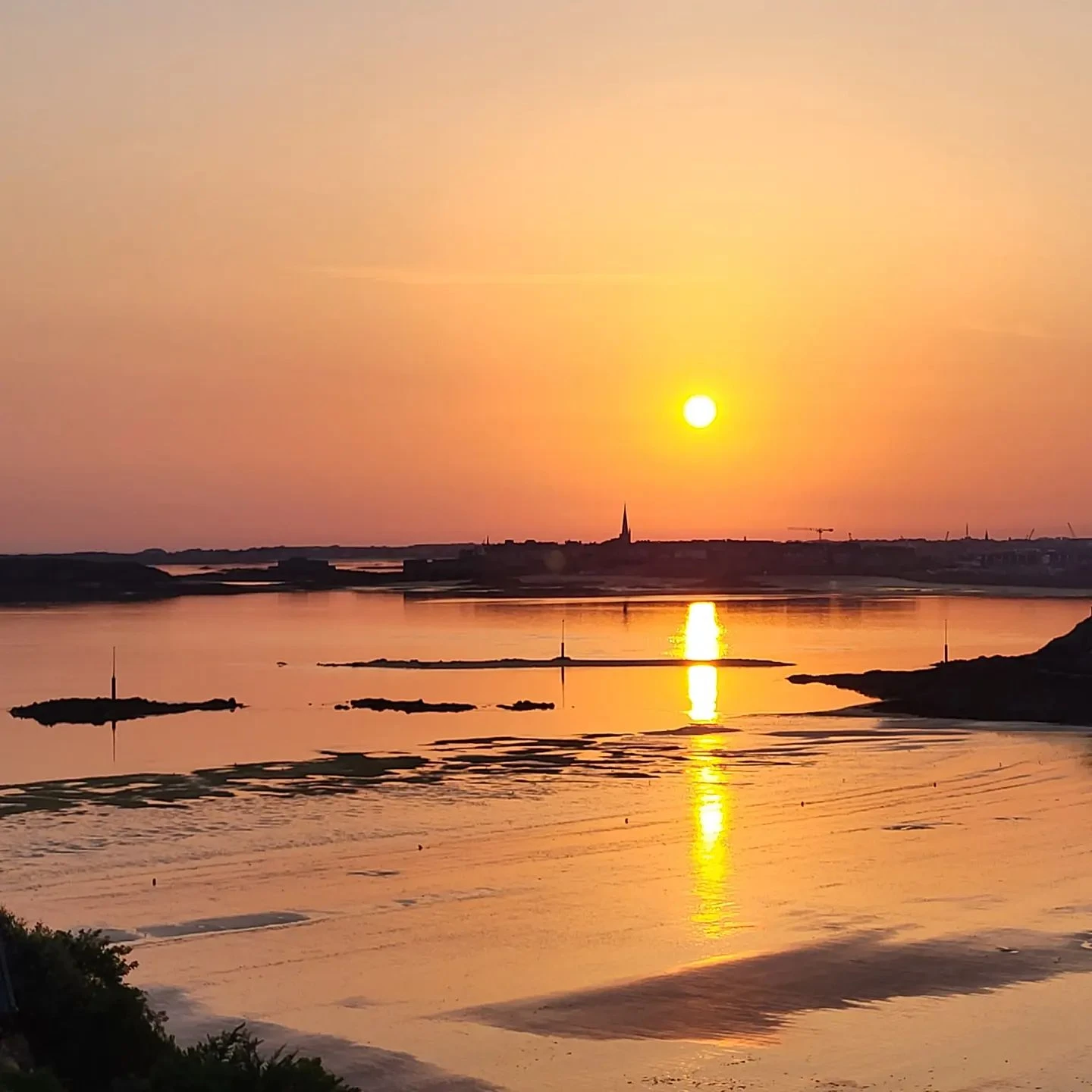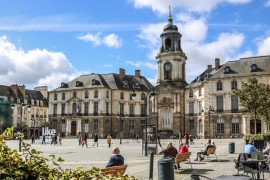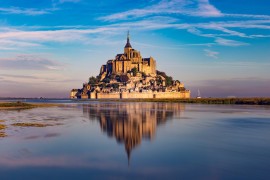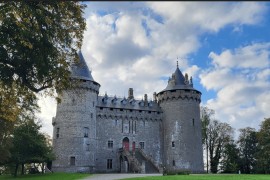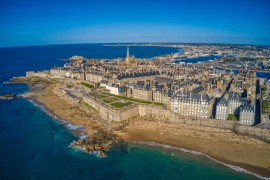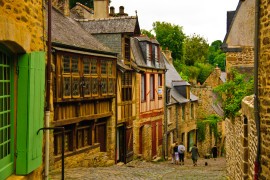What to see in Dinard
Villas on the Malouine headland. Photo chosen by monsieurdeFrance: depositphotos.
The beach "l'écluse" : the great beach
In the heart of the city, you can't miss it. You can rest there sheltered from the wind and it's a pleasure to see the changing sky and the sea. The area along the sand is called "la digue" where you can find culinary stalls to taste a waffle, small restaurants to drink a coffee facing the sea or to have a small dish of mussels. Beware, the gulls are cheeky, always keep an eye on them if you want to keep your dish.
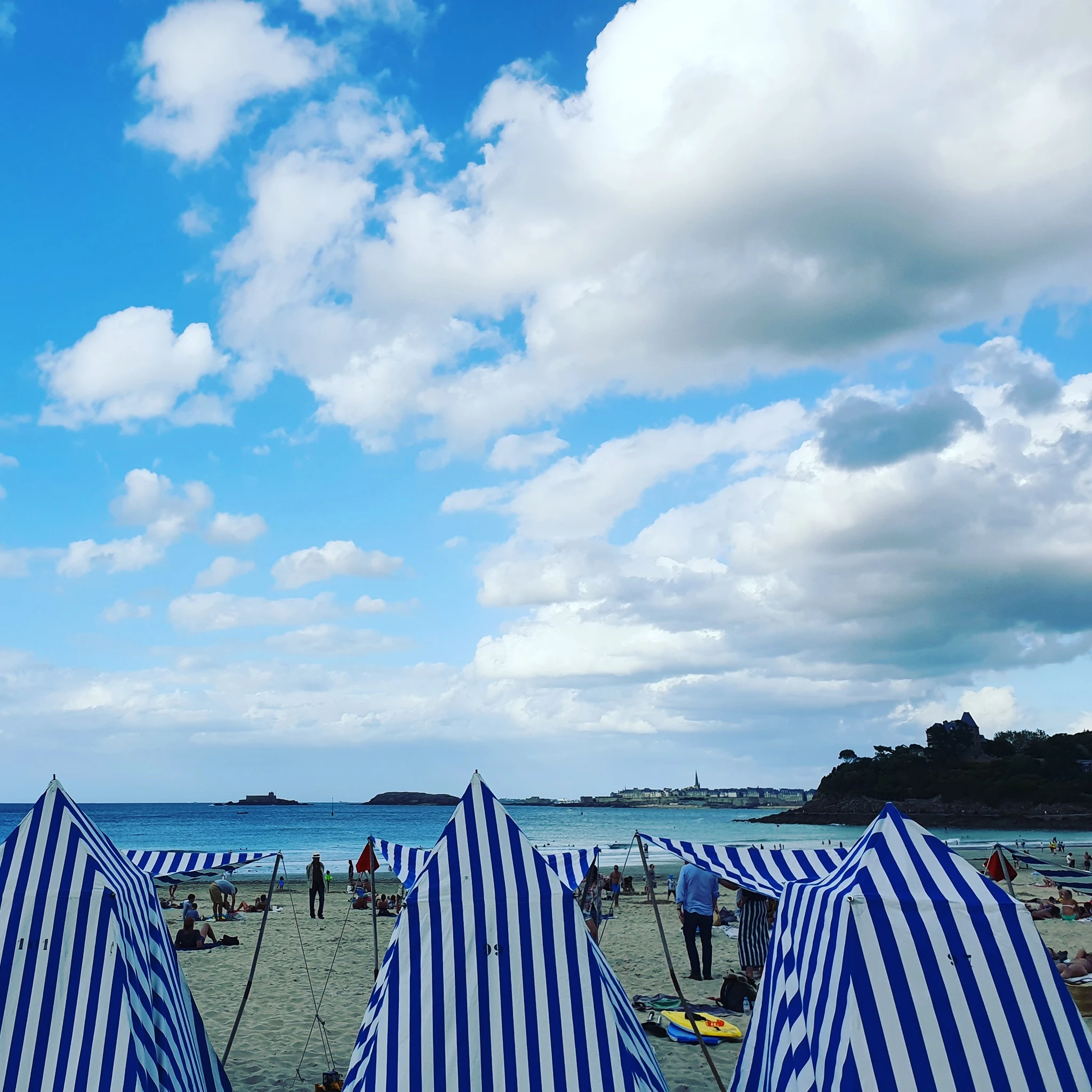 The famous white and blue tents of Dinard. Photo chosen by monsieurdefrance.com: Jérôme Prod'homme (c)
The famous white and blue tents of Dinard. Photo chosen by monsieurdefrance.com: Jérôme Prod'homme (c)
What you see on the great beach :
When you are facing the sea, you have on your right the Pointe du Moulinet, with beautiful villas, including the Villa Saint Germain that you see at the top of the point. On your left, you have the Malouine point. In front of you, the "bé", the small bé is the one on which there is a fort. It is renovated by enthusiasts. We owe it to the genius of the great Vauban when he fortified Saint Malo. The biggest is the "grand bé", it is on this island that Châteaubriand is buried, standing, facing the sea. A little further you see Saint Malo "intra muros", in other words the old city of Saint Malo and the beach of Bonsecours.
The view from the beach of the lock in Dinard: in front of you from left to right: the small bé, the big bé, saint malo and the tip of the reel with the villa Saint Germain. Photo chosen by monsieurdefrance.com : Jérôme Prod'homme (c).
Behind you on the right there is the casino and the swimming pool, on the left, there are two buildings that are worth seeing: the Royal Hotel, now privately owned, but which was one of the most chic hotels in Dinard during the Belle Epoque. It was here that tea was taken in a huge veranda that no longer exists.
The Royal Hotel, once the most chic hotel in the resort, now privately owned. In front, the changing rooms built in the 30s. For some years now, a cabin has been dedicated each year to the person who presides over the Dinard British Film Festival / Photo chosen by Monsieurdefrance.com: Irina Crick/Shutterstock.com
A little further, pink, there is "la Reine Hortense", a pink house, which is a hotel (you sleep well and the view at breakfast is just top). The large living room has a very nice fresco. The house is inspired by the villa of Queen Hortense (mother of Napoleon III) in Italy.
The promenade du Moulinet / Promenade des alliés.
If you turn right from the main beach, you will discover the promenade that runs along the Pointe du Moulinet and you will pass under some of the villas of Dinard. From this point you will have a beautiful view towards the open sea, towards the two Bé, and, further on your left, on the island of Cézembre, which belongs to Saint Malo. This island was ravaged in 1944 during the Liberation of Saint Malo (the first napalm bombing in history took place there). It is possible to go there by boat (shuttles leave from Dinard) and there is a small restaurant there. Still on the Pointe du Moulinet, you will have a very nice view of "les roches brunes", a red and white villa, Louis XIII style, perched on the Pointe de la Malouine (the one facing you). It was built in 1893 by the architect Alexandre Angier for the couturier Poussineau. It belonged for a long time to the Braud family whose descendant, Paul Braud, donated the place to the city of Dinard at his death in 2007. It has become an exhibition space. It is one of the few villas in Dinard that has remained as it is, without having been converted into apartments. A plan, which appears at the entrance, shows the places as they were at the time, for example the servants' quarters or the swimming pool, an incredible novelty at the time.
The villa "les roches brunes" seen from the Pointe du Moulinet. Photo chosen by Monsieurdefrance.com: Jérôme Prod'homme
The villa of the "les roches brunes" (brown rocks) seen of near. Photo chosen by Monsieurdefrance.com: Shutterstock. com
On the "promenade des alliés" you have the most beautiful view of Saint Malo, the ramparts, the bell tower of the Saint Vincent Cathedral (rebuilt in concrete after the destruction of a large part of the city in 1944). On the right side of "intramuros" (that's how the old city of Saint Malo is called), you can see very well the harbor, and a little more on the right, the City of Aleth and its trees. It was an important defense place for the Nazis during the war and it is behind this place that was Aleth, the original city of Saint Malo, whose inhabitants went to settle on the rock on which Saint Malo is built from the 12th century.
The view on Saint Malo from the Pointe du Moulinet. In the center: the bell tower of the Saint Vincent Cathedral. A place which speaks to the Quebecers since it is there that Jacques Cartier rested. And a plaque reminds us that he had the expedition he wanted to lead to China blessed there, but which led him to discover Canada.
The villa "la garde" in winter that you will discover while going up from the Pointe du Moulinet. Photo chosen by Monsieurdefrance.com: Jérôme Prod'homme.
While continuing you will reach the magnificent "Villa la Garde" built in 1897 for Jacques Hennessy. Of "return of gothic" style, inspired by the English castles of the 16th century, it is enormous and articulated around a central hall which was used as ballroom. There is a replica in Newport. Further on, to finish the walk, you will discover "le bec de la valée", one of the places where the first tourists disembarked at the beginning of the Dinard seaside resort. You will meet some fishermen. Passing under the suspension bridge, we find the "plage de l'Ecluse". A word about this bridge to say that it was built after the rock of the Pointe du Moulinet was pierced to allow a passage. A dynamite digging that impressed a lot at the time, which earned the place an inauguration with great pomp.
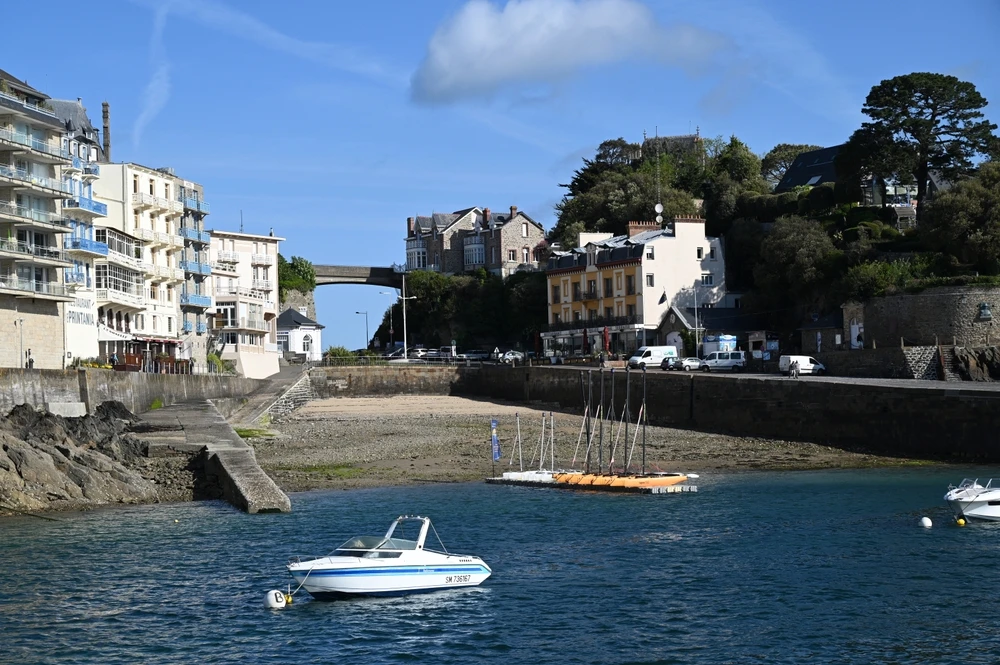
The Bec de la Vallée with the famous bridge. To the left of the bridge you will see the huge "castle of the two banks" of Count Rochaïd Dadah, one of those who made the glory of the city by building and selling houses. We owe him in large part the arrival of the train at the end of the nineteenth century and also houses with a social dimension built to house workers and prevent them from living too far from their place of work. A problem that affects, moreover, the seasonal workers of today who have a lot of difficulty in finding accommodation in Dinard because of the prices and the few offers, most of the offers being reserved for tourist rentals. Photo chosen by monsieurdefrance.com : Shutterstock.com
The moonlight walk
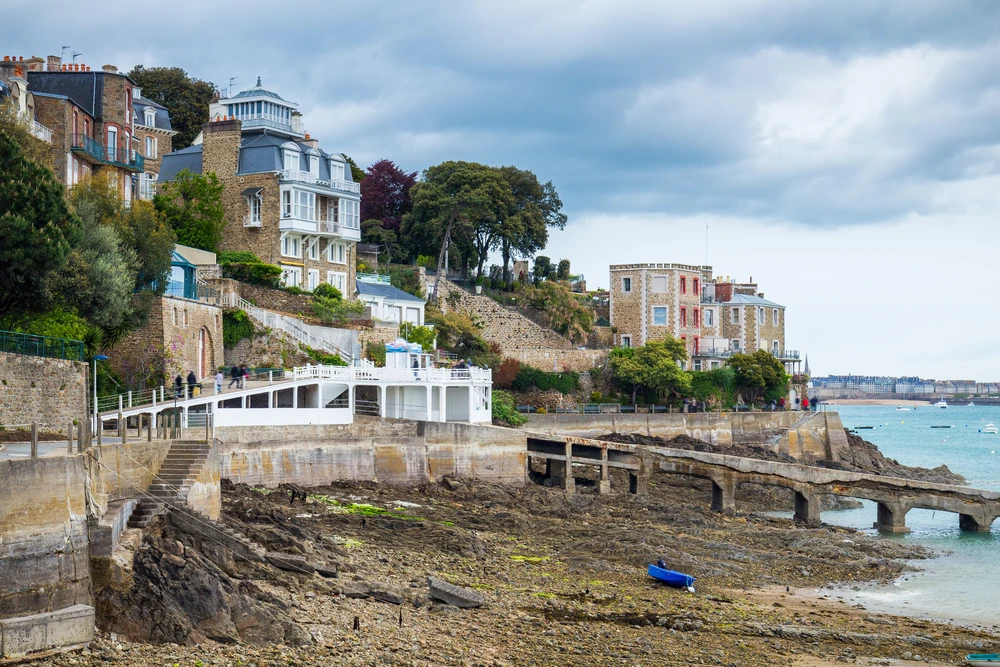
The moonlight walk at low tide and the landing stage of the boats that allow to go to Saint Malo by bus (to do!). It's nice and it's practical because you don't have to look for a place to park in Saint Malo) or to go to Cézembre, Chausey... Photo chosen by Monsieurdefrance.Com : Shutterstock.com
Continuing along the Printania, you start the "moonlight walk". It continues along the sea and leads you to the Prieuré beach, not far from this priory which is the oldest place in Dinard since it was founded in the Middle Ages by two knights to welcome the pilgrims on their way to the Mont Saint Michel. Their graves are classified as Historic Monuments. The walk is flowered and lit in the evening, it offers a nice stroll which allows, among other things, to reach the marina of Dinard (whose Yacht Club is a very nice building of Breton style with Art Deco touches). You can climb the gardens to get back to the city center or the Grand Hôtel Barrière. Note the half-moon-shaped projection of what was for a long time the Dinard aquarium and which is now a luxury hotel: the Castel Brac. A "castel brac" which takes its name from an astonishing villa imagined by an English owner who mixed all the architectural styles and who, asking his opinion to an English friend on the beauty of the place was answered "what a bric-a-brac!
The walk in the moonlight. On the right, the Prieuvé beach, in the center, the marina and on the right, the church tower of Dinard: the "bric à brac" villa and its half-moon overhang above the moonlight promenade / Photo chosen by Monsieurdefrance.com: Shutterstock.com
Go along the sea to Saint Enogat
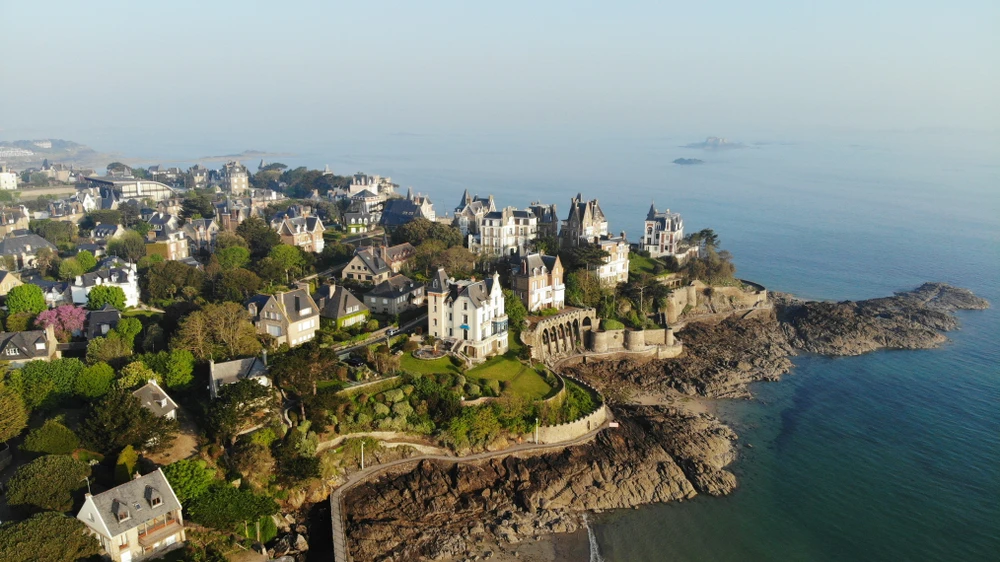
Aerial view on the Malouine point and the villas of the "Poussineau housing estate" built between 1890 and 1930. Photo chosen by Monsieurdefrance.com : Shutterstock.com
When you leave the "plage de l'Ecluse" (the big beach) you take a left and a walk, which is about 2 kms long, will lead you to Saint Enogat. This is the original village of which Dinard was only a place called, a place of passage of the river Rance coming from the West to join Saint Malo. Saint Enogat was a village which lived partly from fishing, from the sale of goemon (excellent to fertilize the earth), from breeding and which provided sailors to the Malouin crews. A republican place in the heart of the Chouanne countryside, the village saw the arrival of the first English tourists at the beginning of the 19th century and the birth of the seaside resort. It should be noted that the relations between Saint Enogat and the seaside resort were not always smooth, especially when it was decided that the parish church would be in Dinard. The inhabitants of Saint Enogat fought for a long time to rebuild their church which had been destroyed in favor of the one in Dinard. And when they got it, they continued to fight to keep their own parish priest.
The "suspended" foundations of one of the villas on the Pointe de la Malouine. Photo chosen by Monsieurdefrance.com: Shutterstock. com
While taking this walk, you will discover some of the most beautiful villas of Dinard. Some of them are architectural feats since they are built on foundations that were made flush with the rock. You will pass under the largest, the Grey-stone villa, an Art Deco splendor that belongs to the billionaire François Pinault. A small beach (washed away with the rising tide) offers some beautiful buildings, including an amazing enclosed gazebo. You can go back to the city at some point, and walk the streets of the Pointe de la Malouine and the Boulevard de la Mer to discover other villas. Or you can continue towards Saint Enogat, go up the village, and continue towards the Thalasso of Dinard. The bar is accessible even if you are not a curist. It offers a sublime view towards the sea.
View on Saint Malo from the beach of Saint Enogat while going back to Dinard via the promenade of the Pointe de la Malouine. Photo chosen by Monsieurdefrance.com : Shutterstock. com
To see also in Dinard
The center of Dinard is also very pleasant. There are many restaurants. Around the Casino there are beautiful decoration stores, antique shops and ... Chocolatiers. You can also sit around the Yves Verney esplanade and the Art Deco building "le gallic" in one of the bars which are appreciated by the holidaymakers especially in the evening to party. The covered market is exceptional. You can find everything you need to enjoy your food, especially with seafood. To discover also the customs path which goes along "la vicomté" towards the Barrage de la Rance. You can also visit Saint Lunaire and its art deco villas, or Saint Briac a little further. Dinard also has many monuments, even if some are closed to the public. For example the castle and the park in front of the beach of the Priory. The villa Eugénie, at the entrance of Dinard, has been closed to the public for many years. It was built to welcome the Empress Eugenie (who preferred Biarritz) on an official visit. A visit that never took place. A persistent legend says that the cancellation was due to the fact that the little dog of the empress was sick...
The church of Dinard, whose bell tower was destroyed by a shell in 1944 during the Liberation. From the square, you have a breathtaking view of the Rance estuary.
Some good culinary addresses
Dinard is also a gourmet resort. You can discover many restaurants. We particularly recommend "l'abri des flots" located in the heart of the city (place de la République). The menu is varied. Special mention for the luiguinis with truffles, delicious. Also note the "Castor Bellux", pizzeria and Italian cuisine restaurant located at 5 rue Winston Churchill (not far from the Casino). Excellent value for money, you won't be hungry anymore when you leave. Nothing like a birthday party here.
Not far from Dinard
Of course Saint Malo
Saint Malo is the subject of a dedicated article on our site. The city is just opposite Dinard. The two cities have been rivals for a long time. You can discover the fortified city "intra muros" and walk along the ramparts. The beach "le Sillon" (the furrow). Numerous villas also, notably in the Courtoisville district. It is also a great port of trade and fishing from which left the terre-neuvats, these men who left on the fishing banks off Newfoundland to fish the famous cod so popular on the French tables. You can easily go to Saint Malo by bus, from the hold of the valley or from the pier of the Clair de Lune promenade (it depends on the tides). The schedules are rather frequent, it takes 10 minutes, you cross the estuary of the Rance and you arrive at the foot of the ramparts of Saint Malo. The information is here (in english) and also there (there are two companies).
View on the island of Cézembre from the ramparts of Saint Malo at sunset. Photo chosen by Monsieurdefrance.com : Jérôme Prod'homme.
The Montmarin at la Richardais
10 minutes from Dinard, on the same bank of the Rance, you can discover the Montmarin, a magnificent "malouinière" (with a beautiful collection of plants). It was built by one of the shipowners of Saint Malo. The malouinières are pleasure houses that the rich shipowners or privateers of Saint Malo (often both at the same time) had built in the countryside to get away from the ramparts and the noise of the fortified city and to take the fresh air. The Montmarin is a very nice example, as well as the "chipaudière" or the "ville-bague" in Saint Coulomb near Saint Malo.
Dinan
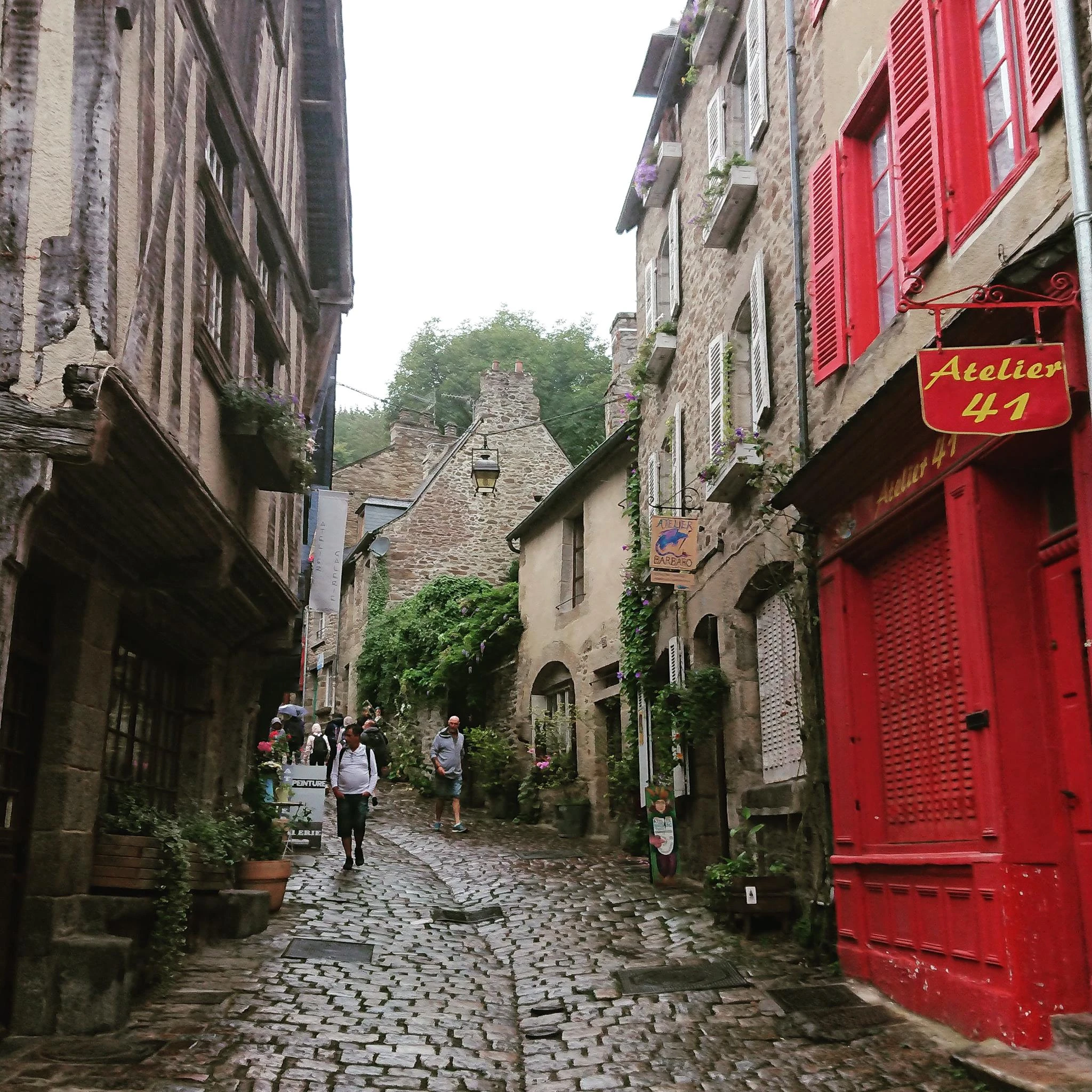
Rue du Jerzual à Dinan / Photo choisie par monsieurdefrance.Com / Jérôme Prod'homme
20 minutes away from Dinard, there is Dinan and its magnificent historical center straight out of the Middle Ages. You can also go down (or up) the amazing and very steep rue du Jerzual to reach the port of Dinan, on the banks of the river Rance (the same river that ends at the Rance dam between Dinard and Saint Malo). There are some nice restaurants and the town is worth a detour. Here is the website of the turists office.
Cancale
25 minutes from Dinard, after Saint Malo, if you like seafood, this is the perfect place to have a seafood platter and taste the famous oysters of Cancale at the Port de la Houle.
The Cap Fréhel and Fort la Latte
The Cap Fréhel seen from Saint Malo / Photo chosen by Monsieurdefrance.com : Jérôme Prod'homme. Photo without tricks and it is one of the strengths of the Emerald Coast: all the lights, all the colors are possible naturally.
At 25 minutes from Dinard, on the same bank of the Rance, you can discover two amazing places. The Fréhel Cape, which advances in the English Channel, majestic and high perched above the water around its lighthouse. The seagull island is also amazing, you can see a myriad of sea birds. A little before, facing the sea and erected on a rock, the castle of "Fort la Latte" is a kind of stone ship above the waves. It is articulated around its round keep. It was the setting for the film "Vickings" with Kirck Douglas and "Chouans" by Philippe de Broca with Sophie Marceau. The place is maintained and safeguarded by the same family since the 50s, the Jouon des Longrais family. The place will impress the kids. Don't miss it.
Le fort la Latte / Photo choisie par Monsieurdefrance.com : Jérôme Prod'homme
The Mont-Saint-Michel
It is not very far, on the other side of Saint Malo and Cancale. The Mont Saint Michel is about 35-40 minutes away from Dinard (be careful in summer it is often longer, there are people on the road). The best way is to go by the coast. You will see beautiful landscapes, but it is also done by a beautiful road which passes off Dol de Bretagne (the cathedral is worth the detour). Monsieur de France gives you all the useful information below.
Dinard or the history of a seaside resort
Dinard: the beach and the famous blue and white canvas tents which sign the city. Photo chosen by monsieurdefrance.com: shutterstock.
A hamlet for several centuries.
Dinard, until the middle of the XIXth century, was only a hamlet of St Enogat, a Breton parish which supplied Saint Malo with sailors, food and also fertilizer, thanks to the dejections of birds on the rocks. The place is one of the rare republican places during the Chouane period, and we are still talking about the village, the countryside being rather Chouannes. Saint Enogat, which takes its name from the 5th bishop of Aleth (Saint Malo) is made up of a village, on the edge of the sea but which turns its back to it and of many hamlets like the Priory, for example, founded by monks of the Middle Ages in the XIIth century, "la grande lande" (the great moor), the pionnière (whose street of the pionnière perpetuates the memory) and Dinard: a port. Well rather than a port, a fishing village and especially a crossing point of the West Breton towards Saint Malo, the opulent commercial city. One takes a ferry, very taxed by the way, which leads to the Corsair City, in particular to sell cloths woven in the countryside with the hemp which likes well in Brittany. A place like so many others, except for a short appearance in History when Duke Jean IV of Brittany landed on August 3, 1379 in Dinard, from England, to reconquer his duchy. What will change everything is tourism.
Seal of Duke John IV of Brittany / Image selected by monsieurdefrance.com
A crush that launched Dinard
It is an American couple, William and Lyona Faber, who will launch the seaside resort of Dinard around 1835 by discovering the site thanks to an English friend who already knew it, perhaps after having been a prisoner in Saint Malo during the imperial wars. It is in any case to the Faber couple that we owe one of the first villas built to take advantage of the magnificent view of Saint Malo. Aware of the potential of the place, at a time when tourism was developing more and more among aristocrats and a certain bourgeoisie, the Fabers bought land and sold it to their English friends, especially those from Dinan, who were soon numerous enough to justify the appearance of a British Consul and the creation of an Anglican church, Saint Barthelemew (which is still in its place today). The English will make their mark in Dinard and put in fashion what they have already been practicing for a long time across the Channel: sea bathing.
The first sea baths
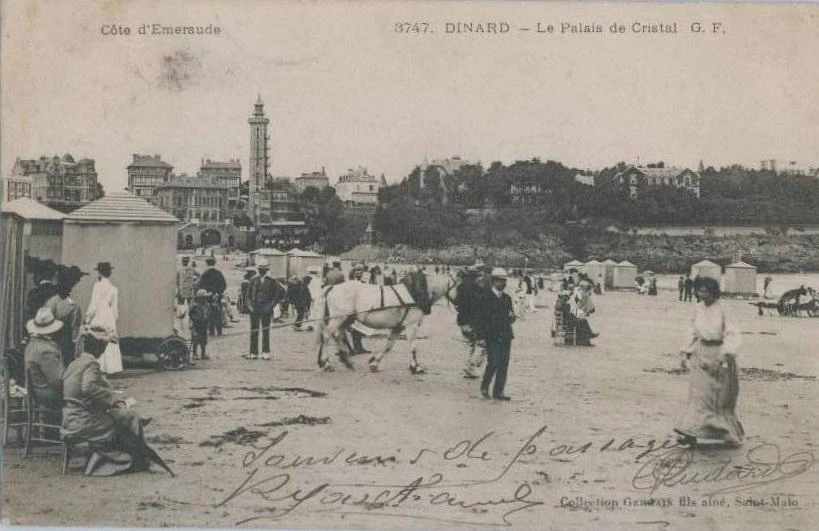
One of the cabins that brought the bathers to the waterfront in Dinard. Photo chosen by monsieurdefrance.com: old postcard.
While medicine was beginning to see sea bathing in a positive light, and it was already fashionable to go swimming in Great Britain, this fashion for sea bathing reached France and in particular Dinard, which saw the establishment of a sea bathing establishment and the arrival of its first bathers. We see them approaching the water on the beaches, especially the beach of Ecluse. The ladies also bathe, dressed in large bathing suits that cover them, and brought to their cabins on horse-drawn carriages that put them as close to the water as possible because it would be indecent for them to be seen so scantily clad. At the same time, the big fortunes begin to build their villas. Coppinger completed his in 1858. They compete in beauty and ingenuity. Everything was possible for the architects, from the English villa with turrets and bow windows to residences inspired by local malouinières. The hotels are more and more numerous and more and more chic. From the hamlet of Dinard, the seaside town widens towards the Pointe du Moulinet, the Plage de l'Ecluse to the point that one starts to speak about Saint Enogat Dinard, before speaking only about Dinard 50 years after the arrival of the first tourists.
A crazy world at the beach of Dinard in the 1910s photo chosen by monsieurdefrance.com: old postcard.
The "Belle Epoque" :
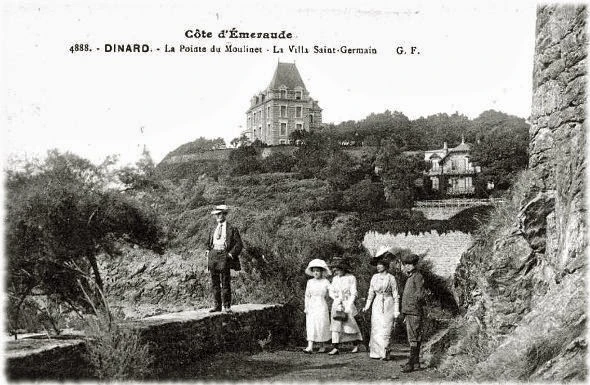
Family of elegant people walking in Dinard on the tip of the reel under the villa Saint Germain (it is still there, on the right tip when you are on the beach).
The years 1860-1914 are the great years of Dinard. The "Season" brings the greatest names in the city. We win his villa (and we rent it when we are not there, Airbnb did not invent anything...), we walk by surveying the paths, we make the stores in Saint Malo, we push sometimes until the Mont Saint Michel. You can go to the beach and enjoy a swim in the sea or see the children playing in the sand or trying to catch crabs in the rocks. The hotels often host shows or concerts (Sarah Bernardt was seen playing in Dinard). The appearance of a new sport: lawn tennis, is so popular that a club (very closed) is created. It is one of the oldest in France. There are horse races on the beach on a regular basis and you can ruin yourself whenever you want in the casinos (the city had several at one time). For the inhabitants of the surroundings, the beach ceases to be this empty and useless expanse to feed themselves and becomes the origin of many jobs.
The "Pearl of the Emerald Coast".
Villas are more and more numerous thanks to entrepreneurs like Count Rochaïd Dadah, of Lebanese origin, who fell in love with Dinard and brought the train. We owe him many works, starting with the construction of his castle on both banks, but also the drilling of a passage between the lock and the Valley (drilling with dynamite and inauguration in the presence of the President of the Republic in person).
Count Dadah and his wife in front of their castle on both banks (just above the bridge that spans the passage between the Plage de l'Ecluse and the bec de la Vallée).
Albert Lacroix proposes the "allotment" by buying grounds which he makes viable and to which he allows access by drawing new streets. It is the beginning of the constructions on the point of Malouine. Tourists arrived in ever greater numbers from Saint Malo, where the train arrived in 1864, via a ferry that crossed the Rance estuary to arrive at the port of this fishing hamlet that was Dinard until then.
A "people" spot
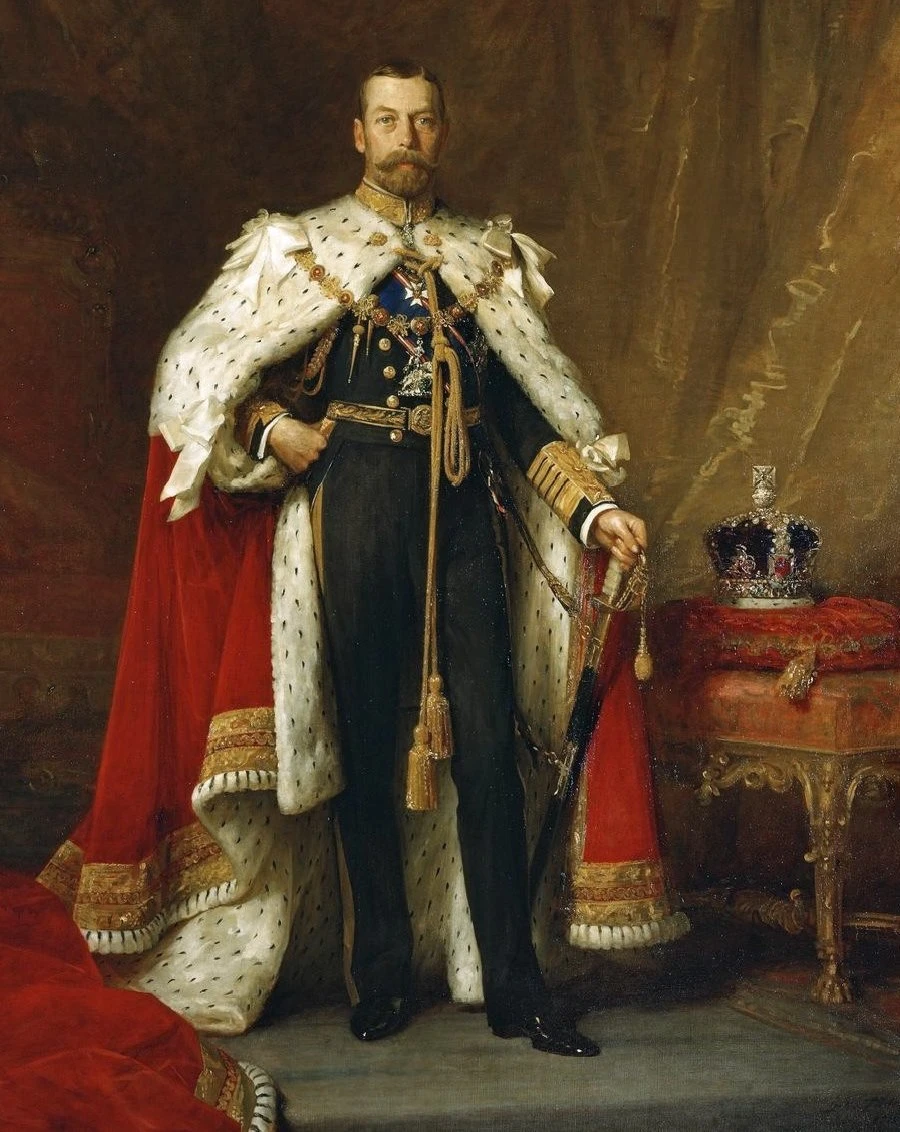
Portrait of Georges V by Luke Fildes (1911).
Many celebrities of the Belle Epoque passed through Dinard. The future king George V and Edward VII passed through. Edmond Rostan (author of Cyrano de Bergerac) wrote there, as well as Paul Valéry. Picasso painted a series of bathers in Dinard, Agatha Christie learned to swim there, Sir Winston Churchill painted there. We also talk about Lawrence of Arabia or, more recently, Serge Gainsbourg who spent his vacations there as a child. Today, celebrities are still seen in Dinard.
Lawrence of Arabia by Sir William Rothestein.
The end of the great era
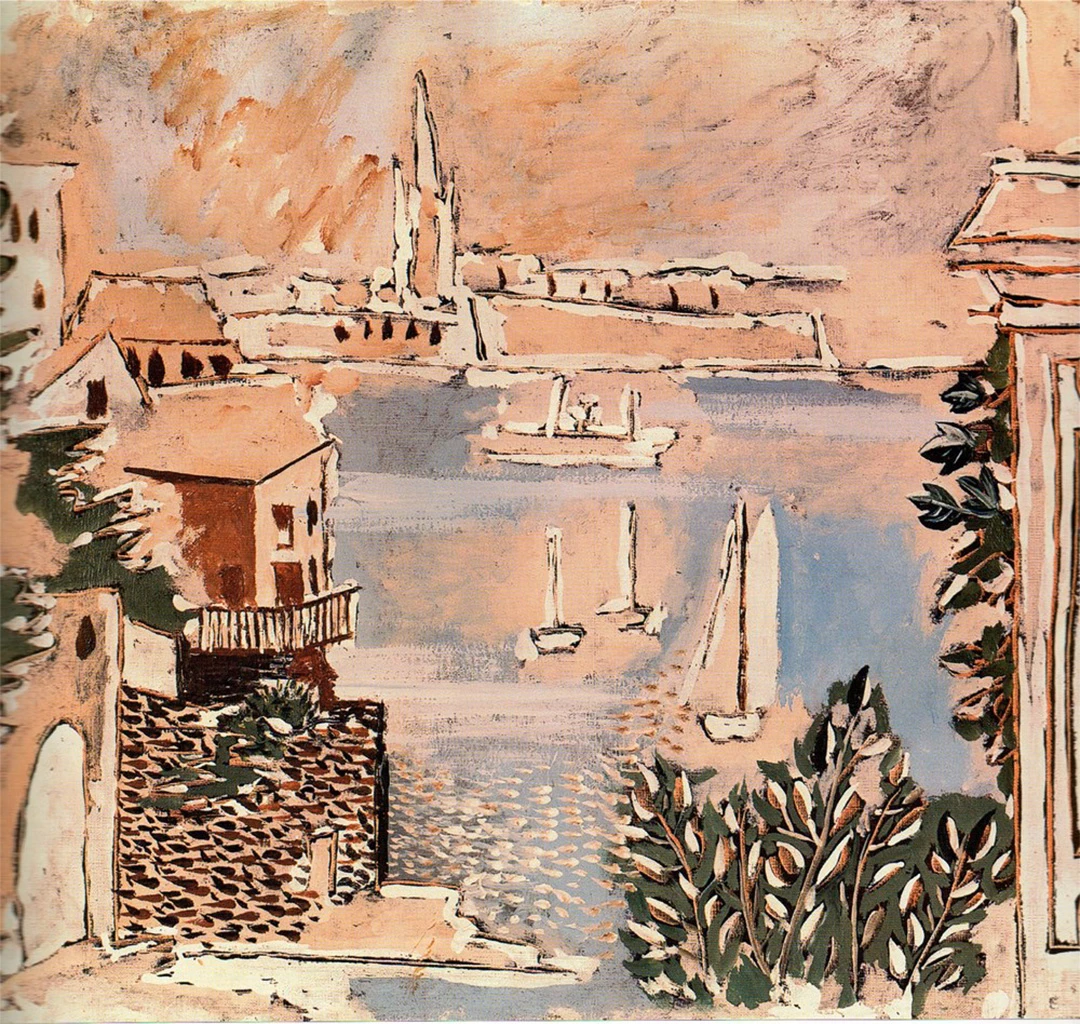
View of Dinard by Pablo Picasso. He stayed twice at the Gallic, in the 30s. An ultra modern hotel for its time, since almost all the rooms had a bathroom. A great first.
The First World War dealt a first major blow to Dinard, which was born of an aristocratic way of life that disappeared with the war. Between 1914 and 1918, the hotels were transformed into hospitals. The Roaring Twenties saw the return of tourists and parties were held in many villas, including the one that has become the town hall nowadays. The 30's saw the birth of the "dike" and the "promenades" which allowed people to walk along the coastline. The 1929 crisis dealt a new blow to the city when the British, ruined, sold their homes and the coup de grace was given by the Second World War.
The rebirth
Dinard / Photo choisie par monsieurdefrance.com : Shutterstock
After a difficult period, when tourists preferred more modern resorts, Dinard was finally reborn at the end of the 80s. This period of "oblivion" allowed Dinard to avoid what happened to other seaside resorts: the destruction of its heritage. No brand new buildings in place of an old villa since the city is not in demand. With the return of tourist interest in the 1990s, the mayor of the time, Marius MALET, had the idea of protecting the town from destruction and had several hundred villas classified. A "dinardais style" is imposed on all new constructions. International cultural events are set up such as the British Film Festival (which first saw "Love Actually" or "4 weddings and a funeral"), the piano festival or the fashion festival. Dinard shines again. And for a long time...
Geo Info / Websites
Dinard is populated by a little less than 10 000 dinardaises and dinardais. It is located in the department of Ille-et-Vilaine and in the region of Brittany. The tourist area of Dinard is the Emerald Coast.
Go to Dinard by train.
There is no train station in Dinard. The nearest TGV station is Saint Malo and puts you at an average of 2H36 from Paris Montparnasse. Buses or cabs are available to reach Dinard. You can, for example, go up from the station to Intra muros by bus, take the boat bus at the foot of the ramparts to the Porte Saint Vincent, and arrive in Dinard by water. It is necessary to count 1H all included.
Go to Dinard by the road
By car, you are about 35 minutes from Mont Saint Michel, 45 minutes from Rennes, 4H30 from Paris (via the A13 Caen) or even 4H40 (via the A81) or 5H20 in a route without tolls). Buses allow you to come from Rennes.
Go to Dinard by plane
There is the airport of Dinard. It is located in Pleurtuit. It offers some destinations, notably to Great Britain. Here is the link to discover the destinations. There is also an airport in Rennes, the airport of Rennes Saint Jacques, at 1H00 from Dinard by road.
Websites :
The site of the tourist office of Dinard is here.
The site to visit Brittany is here.
Please excuse our translator. He partied in Dinard (yes! It's also a great town for evening fun)... As a result, he's not very fresh and he may have made some translation mistakes.
Sunrise over Dinard and Saint Malo / Photo chosen by Monsieurdefrance.com : Jérôme Prod'homme.

